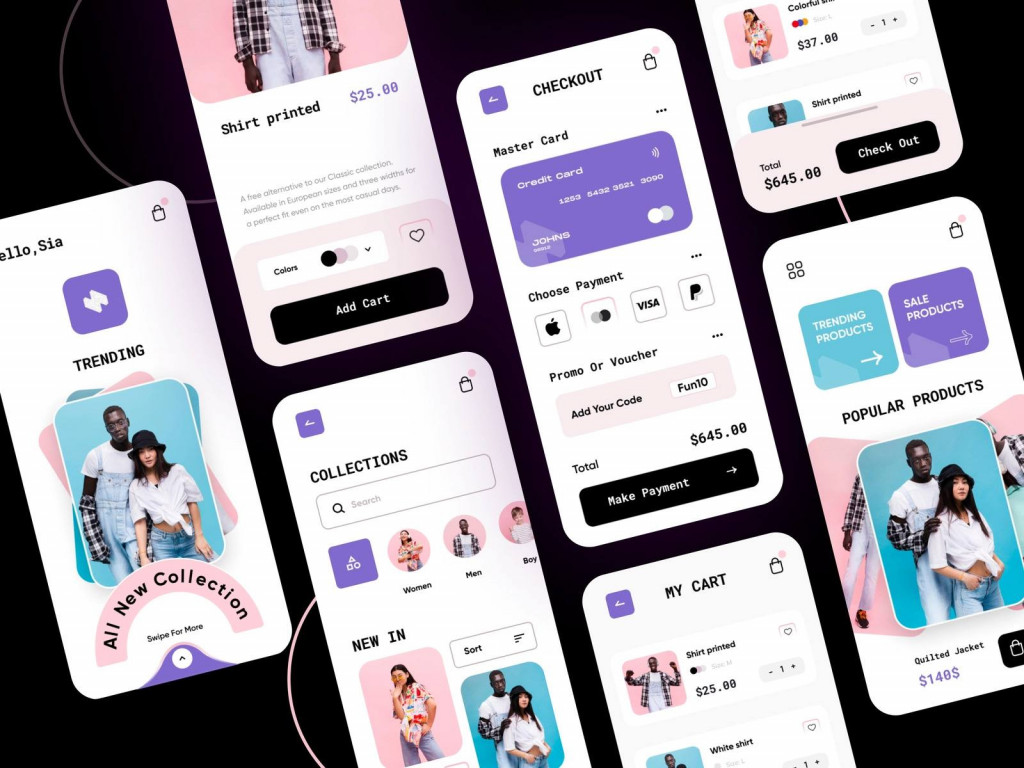With the increasing demand for online shopping and virtual assistance, businesses are expected to provide a seamless and personalized customer experience. However, these expectations are hard to fulfill without large expenses. How to cut costs and stop spreading your team efforts thin? That’s where ChatGPT comes in handy.
Contents:
Approximately 25 million people turn to this tool daily, making 10 million daily queries. Apart from writing texts and making content, there are other ways for you to use ChatGPT. By integrating its API into your software, you will be able to speed up the working process.
To demonstrate the power of this neural network, we asked our colleague Sergey Efremov, who has successfully created a demo of an e-commerce platform powered by AI. He is an experienced team lead and has been experimenting with chatbot capabilities for several months. Together, we will explore the benefits of using ChatGPT for your business and provide tips for getting started.
Let’s start with the basics. Why did you choose ChatGPT for your e-commerce business demo?
This neural network is one of the most affordable conversational AIs in the world. It was initially developed to simulate human-like speech. Usually, such technologies are trained for one special task. With ChatGPT, however, you get your hands on a vast toolkit for which you would normally use a bunch of other neural networks. Therefore, you can fulfill different assignments by sending prompts for reports, reviews, analyses, solutions, etc.
Moreover, this neural network has an easy-to-use API that can be integrated into the software without much fuss. If you create the integration with Open AI, you need just one endpoint to receive texts (the tasks you need to make). It demands less maintenance and coding. You just have to generate tips for GPT and provide data — all in one code. As a result, the developer writes a few lines once, then you create a service where you enter any hints or info for prompts and send them. The format is also universal: .json, .xml, .csv. The chatbot will understand and parse them no matter what format you pick, giving you the desired answer.
Sounds nice. How can we use ChatGPT in the e-commerce business?
There are various ways of implementing a chatbot into your workflow. Here is what I’ve checked out and it works perfectly for me:
AI-powered search
When a client visits an e-commercial website, they often look for a product using absolutely different tags or words that we cannot predict. With the neural network API, you can create a smart search. Feed all the data about the products to the chatbot, and it will suggest suitable items to customers.
Upselling
Apart from suggesting items, AI can make an upsell and offer additional products like guarantees, gift cards, and other items. All of them will be based on the user’s intentions and preferences. As a result, you will provide a tempting offer to your clients without much effort.
Gift cards
Few of us are great writers or poets. When it comes to wishes and congratulations, people often struggle with words. Let your clients enjoy the gifting process by offering them a built-in generator. One click — and they have a human-like text that warms the heart. It is also possible to tweak the initial prompt a bit: who the sender and recipient are, occasion, item, names, etc.
Let’s take a look at the example. You have an online jewelry store. A client wants to buy a necklace and gift it to their wife with a heartwarming card. They can type in a few words to guide the AI, and then receive a short congratulation that fits the occasion and necklace.

Ecommerce – Mobile app by Anastasia Golovko
Live chats
As I said earlier, ChatGPT has a human-like speech thanks to NLP (Natural Language Processing). That’s why it’s perfect for integrating into live chats. Based on the provided data, Artificial Intelligence will interact with potential customers online. Moreover, you can feed it with F.A.Q. that the client never actually reads, and the chatbot will provide the necessary information in an easy-to-grasp way.
SMM & newsletters
If you need to advertise certain products and don’t want to spend much time creating texts, ask AI for help. It can write cold and warm e-mails, e-mail chains, subjects, social media posts, etc. ChatGPT handles emoticons and hashtags really well, so you just need to set up a correct prompt.
SEO
Using AI-powered services, you can start generating SEO content like headers, names, descriptions, monthly plans, and keywords that are crucial for dealing with search engines. This will help you boost your e-commerce business online. What’s more, it’s possible to write short stories and find interesting facts about your products. Storytelling can be used in SMM, while facts will increase user retention time on your website. This leads to a better ranking.
Localization
ChatGPT is good at translating content into other languages. There are other services like DeepL that show better results, but they are aimed at localizing texts only. So, you can use the chatbot for creating content and translating it at the same time. Don’t forget about proofreading, though.
Ideas & inspiration
Tell AI about your business and ask it about new strategies or items you could try creating. If we take a jewelry company, the owner can describe their wares, composition materials, methods, and target audience. In return, they will get new possible mixtures, packages, gifting boxes, jewelry types, shapes, etc.
Reports & analysis
Artificial Intelligence can analyze large amounts of data and reports back with statistics. ChatGPT 3.5 are bad with mathematics, so it provides incorrect numbers. However, version 4.0 is much better at counting — I’ve already tested that. Still, if you don’t need the exact numbers, you can use 3.5 for predictive analysis and see uprising trends or anomalies.
Customer service
Chatbot is able to generate answers to the users’ reviews, and it does this job really well. Honestly, even better than me. Moreover, intelligent algorithms can divide reviews and support tickets by category. Just give ChatGPT a list of these categories and it will assign the ticket to the correct group. Apart from this sorting method, you can also divide messages by intent.
Video
If you combine ChatGPT with other networks for video generation, you will be able to create mindblowing things. To give you an idea, imagine that a client browsed the website but didn’t purchase anything. A bit later they get an e-mail with a personalized video where a business owner addresses them by name and persuades them to buy the goods. So, you can record a video once, create a template, and the AI will use it to generate clips meant for other clients. As a result, the number of website conversions spikes. Even with a personalized voice message, the rate triples, so with the video, it will reach new heights. I believe, in this case, content personalization becomes really powerful.
Images
Midjourney can create an image of the same person in front of various backgrounds. Use it to boost your content creation — generate a pretty-looking model wearing different items in several locations. The human model won’t be static, Artificial Intelligence can rotate the head, change posture, hand position, and other stuff. Also, you can create a human with a unique appearance in seconds, and in reality, this person will not be existing. So you won’t be taking anyone’s real photos or videos.

Home page design for Jewellery store by by Alina
I believe these technologies are great not only for selling goods but also for selling services. Is that correct?
Yes, you are correct! Small and medium businesses can take advantage of AI in various spheres: banking and financial services, healthcare, telemedicine, cosmetics & beauty brands, app development, etc. Although some features are still rough, like video and voice generation, they are improving by leaps and bounds. So we will have human-like tools in a few months.
ChatGPT 4.0 will release a plugin system soon. For instance, it will be able to work with images. Upload one picture and ask the chatbot to make modifications: change colors, head position, or something else. And unlike Midjourney, it will change only the pointed area. The plugins will also grant us the ability to collect up-to-date information. If you didn’t know, the 3.5 version is still limited to the events of 2021.
There are some custom plugins already, but with an input limit of 4096 tokens (which equals approximately 3 000 words), they are not very effective. If you’ve started a dialog, and you’ve exceeded the limit, the chatbot will forget the beginning of the conversation. To talk with ChatGPT for a long period, you have to remind it about the initial topic constantly. How I do this: after a few messages, I type in ‘Summarize our dialog’ and copy-paste it into the next message to freshen up the memory. Still, it won’t be able to work with large existing projects — it simply can’t process them. We can’t pass all the existing code to GPT to generate the correct lines for us based on the input. On the other hand, there are already systems that work with large systems, for example, AWS Codewhisperer.
Fortunately, the Open AI extension will not be restricted anymore. Also, version 4.0 is smarter than 3.5 at making code. The amount of fixes I implement during code generation has been reduced by five times.
How to integrate AI into the website?
It’s rather simple. However, you will need a skilled developer to write backend code for calling API. Start with a point where you will send the data, then enter your API key. Now the developer should create another piece of code using JavaScript. It should collect the data from your forms and send it to API.
So the programmers won’t be left behind without a job, at least for now.
What about the data privacy in the chatbot’s dialogue? Is there any risk of leaking?
It’s a complicated question. There are no guarantees from Open AI that your texts won’t be used elsewhere. So they can be taken for training. If you have any sensitive data, it’s definitely risky, and I’d not recommend sending it to the chatbot. However, I believe the company will change this situation in the future. Just like GitHub for their CoPilot, they might create a separate business subscription with a secured channel. So the data sent there is not being used anywhere else. We will see how it goes, though.
The digital features are very tempting. How to not overdo it and not ruin the business?
You can’t use ChatGPT as it is. The main rule is chatbots are here to help, not solve everything for you. You must control the logs and responses, and check the results. Each generation is unique, so even creating categories won’t work — some products may eventually fall under different labels. However, categories with clear aspects need a correct description.
Ideally, get a prompt engineer who knows how to write texts correctly with all the necessary hints. You see, if a user type something in a chat, you can’t just send this raw message to AI. It should be accompanied by a system message such as: imagine that you represent this brand, are not allowed to speak about other companies, etc. So when people ask about Nike sneakers in chat, the neural network should not mention Reebok sneakers.
What’s more, using raw texts from ChatGPT is not recommended. It can make grammatical and stylistic mistakes, especially if you use other languages. Therefore, you need an editor to proofread and improve the texts. Remember, that all-around automatization is impossible. Some tasks simply can’t be forwarded to AI without drastically or completely losing quality.

E-commerce Web Design by Yasir Ahmad Noori
Actually, Artificial Intelligence is not about automation. It’s about searching and generating ideas and implementing them. I have a real case that happened during production at Shakuro. We spent a lot of money to store the data in the AWS cloud. After brainstorming this issue, the team came up with an idea to zip the information. That decision could cut the costs to probably 80%. However, later we asked ChatGPT if it could suggest something else. The chatbot offered 5 solutions. Apart from zipping, AI also mentioned that AWS had special services to reduce traffic, and we didn’t know about them!
As for generating ideas. Although the chatbot is bad at reports and numbers, it can tell you the metrics required for these reports, why they are important for business, and how to perform conversion rate optimization. Moreover, it can assist your team in coding the data for acquiring the metrics.
When I did the presentation website for AI tools, I also asked ChatGPT 3.5 for help with coding. If I did the code, JavaScript pieces, and UI myself, it would take me a couple of months to finish. With the help of the neural network, I created everything in less than a week.
Sometimes it makes mistakes, of course. Once, I had to renew the production database and needed to write a query to do that for me. AI generated a code but there was a wrong field. So, I’d mess up everything if I just pasted it.
Do you have examples of real cases where ChatGPT helps cut project costs?
Here is an example of a drastic cost reduction from my working experience. I worked with a business that paid around $50 000 a year to a service provider to process the tickets with clients’ complaints. The accuracy of determining the initial client’s problem was close to 60%. When we tried ChatGPT as a substitution for that service, the accuracy spiked to 90%. As a result, the company manages the tickets automatically with AI while still maintaining high quality and saving those $50 000.
The same goes for text localization. Product descriptions have to come in 5 or 10 languages, and you need to pay a hefty sum to the translation companies. ChatGPT can automatically localize the texts, and all you will need to do is proofread. It’s much cheaper in the end.
One of our business owners came up with the idea for customer support. Before the experiment, the time required to process 10 tickets was around 60 minutes. We integrated ChatGPT into the system and provided it with pre-made templates. So it generated two possible answers for customers according to those settings. The support manager needed only to pick what variant suited the situation better and send it. As a result, people can respond to approximately 100 tickets an hour. As you can see, that’s a lot of money because now we can hire one person instead of a whole squad.
Another great idea I’ve encountered is using AI for a song-generation service. So, before integrating the neural network, people would visit the website, and enter their names and the lyrics of their favorite song. Then, the company would generate the cover for this song with the texts. But with the chatbot, the user can just enter the basic data like names, and favorite genres, and it will generate a whole new song with these names. Here, the company can also attach a cover created by Midjourney.

Ecommerce Website by Nishar Multani
Will ChatGPT replace all human specialists? Should we be afraid of it?
No, of course not. This is just another ‘spiral of evolution’, where our working processes are improving. So chatbots will not replace humans, they will replace those who won’t use the new technology. If you want to stay ahead of the competition and not be left behind, it’s better to start acquiring these skills.
Wrapping it up
The use of ChatGPT and other AI technologies in the e-commerce business has both advantages and disadvantages. On the one hand, Artificial Intelligence can provide personalized customer service, optimize product recommendations, and automate repetitive tasks, resulting in increased efficiency and sales. On the other hand, it can make mistakes and doesn’t provide data privacy. Still, ChatGPT is becoming increasingly prevalent in the e-commerce industry, and it is likely that this trend will continue in the future.
Do you need to create a cutting-edge mobile or web app with intelligent algorithms? Contact us and we will build a demanded product featuring a vast toolkit and the latest trends.
Created by Sergey Efremov & Mary Moore
